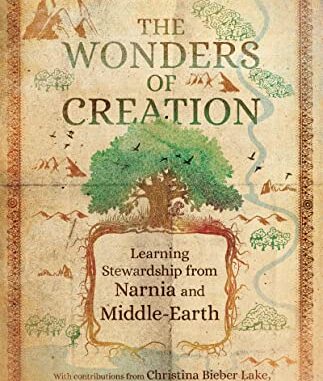
Hey, everybody! Welcome back to Tumnus’ Bookshelf, where we review any and all books written by, about, and inspired by CS Lewis, The Land of Narnia, and The Inklings. For today’s review, we will be looking at Kristen Page’s The Wonders of Creation: Learning Stewardship from Narnia and Middle-Earth!
TITLE: The Wonders of Creation: Learning Stewardship from Narnia and Middle-Earth
AUTHOR: Kristen Page, et all.
PUBLISHER: IVP (November 2022)
ISBN-10 : 1514004356
ISBN-13: 978-1514004357
Summary:
Derived from her lecture series at Wheaton College’s Marion C Wade Center, Professor of Biology Kristen Page examines how the fantasy worlds of CS Lewis’ The Chronicles of Narnia and JRR Tolkien’s The Lord of the Rings can better help believers develop a love for God’s creation and become better stewards of the gift they have been given. From how time outdoors and physical activity can help stimulate creativity, and a healthier lifestyle, to how caring for what God made can be an act of loving one’s neighbor, she challenges many conceptions that exist about stewardship and creation care. In response to her claims, other distinguished professors of Literature, Theology and Politics and Urban engagement expound upon these themes within the understanding of the respective academic disciplines.
Review:
CS Lewis once observed that when it comes to fantasy worlds the reader, “Does not despise real woods because he has read of enchanted woods; the reading makes all real woods a little enchanted.” This has certainly been the case in my life. Growing up in Minnesota, it has not been uncommon for my mother to point out in the fall how the golden leaves on the birch trees make her think of Lothlorien, while a walk through a nearby park adorned with Edwardian style lampposts during first good snow fall of the winter will inevitably lead her to point out to me how she almost expects Mr. Tumnus to pop out. Even my dad got into this a summer ago as we hiked a volcanic trail along Mount St. Helens and he not only compared it to Mordor, but in turn used this helped me power through with my raging sinus headache due to a higher-than-average pollen count. Using these images and sparking the embers of my imagination, my parents and I have used these works to make our hikes in nature more magical and wonderous, helping it feel not like laborious exercise, but an adventure of our own making.
Much of this is due to the fact that beyond just the fact that they were writing at a time in which authors were expected to create “pictures with their words”, thus for readers of CS Lewis The Chronicles of Narnia and JRR Tolkien’s The Hobbit and Lord of the Rings they can attest to how real and vibrant each world feels. One step through the wardrobe with Lucy and one can feel the crunch of snow under their feet, while one can feel the leaves of Lothlorien as they travel with Frodo and company. Much of this is due to just how much both men loved nature from their boyhoods, and well into adult hood. Many of their conversations together were not just in stuffy offices or smokey pubs, but outdoors in a park. Further, it becomes clear through reading their works and studying biographical information just how much memories of pastoral England and Northern Ireland influenced their respective creations, all the while for Sauron to lay waste to the forests of Isengard or for Shift the Ape to order the felling of the trees of Narnia is seen as a travesty.
Other authors such, as Devin Brown have often alluded to some of the themes of creation care that exist, and how both men believed nature can spark imagination, but few have bothered to look at just how these words and images can help cultivate our own love for the wonders of creation around us. For Christians it is part of our sacred calling from God to care for the Earth as good stewards, one that Lewis and Tolkien seemed to understand. Wheaton University Professor of biology Kristen Page sought to do exactly that in her lecture series, now collected in this book, The Wonders of Creation: Learning Stewardship from Narnia and Middle-Earth.
Right off the bat, Page makes it clear that much like Lewis believing his works could help readers “steal past watchful dragons” of dogma to the core of Christianity, that fantasy worlds like Narnia and Middle-earth could make readers think and feel differently about their role as stewards of God’s creation. She even acknowledges, citing Robert MacFarlane of Nature Magazine, that books and films that are directly about the environment may turn people off and will only reach those already interested, and that far too often those works can come across as dull, boring, and preachy, or worse flat out condemning the viewer and urging an extreme approach.
Page’s book is thankfully nothing like that. As it is derived from her lecture series at the Marion E. Wade Center at Weaton college it feels like the lecture notes delivered by a favorite professor. Each chapter even has subsections that feel not unlike bullet points in a classroom lecture to help students pay closer attention and get to the core of the idea. Like any professor, her job is to get her listener to think and examine a topic deeper, not bore them to tears.
The first chapter of the book, “Stepping out of the Wardrobe” is a simple call to action, urging readers to step out of the confines of their indoor spaces and explore nature and drink in the wonders of God’s creation. It goes beyond just taking a brisk walk, but honestly “reading landscape” and urging readers to allow it to transform us, our imagination and our outlook on the world and how we care for what God gave us. Here, she uses Lewis and Tolkien as a prime example, how their time in nature lead to the vibrancy of Narnia and Middle-earth, and how those landscapes in turn transform us and seem to enrich our experiences in nature before calling upon readers to consider our role as caregivers of God’s creation and what our ethic in that regards should be.
It is her second essay however, that is the bitter herbs of the text. Here, she laments the loss of creation, beyond just deforestation but calls attention to brownfields, and chemical dumps and how they have poisoned water and, in the process, children. She also highlights how the loss of valuable ecosystems has led to a proliferation of diseases like Zika, West Nile, and Covid-19. It is a difficult, but an important read part to read. One cannot be motivated to action until they lament, and it is this chapter in which she peels back the readers mind and shines a light on some of the ways that some have fallen more in league with Saruman in Lord of the Rings and Shift the Ape in Narnia.
Her final chapter,” Learn from the Animals”, may sound weird, but it is here where she applies what she was arguing after the lament. Far from a “back to basics” call, she is instead suggesting that humans learn to find ways to make sacrifices to live responsibly not taking more then we actually give. Further, she encourages readers by reminding them of the many benefits that can come from nature, including better mental and physical health that simply come from getting outside and enjoying the fresh air and going for a walk, including decreased stress and anxiety and better sleep
Each essay is followed by a response from a different distinguished field of study, including literature, theology and politics. There is something about this interdisciplinary aspect of the book that is particularly enriching. Far too often the topic of environmental studies is reduced to just a matter for politics or science. Here, Page and her colleagues show that the disciplines can and should work together. Facts and figures are well and good, but the arts can make us feel and think deeper about those facts, and theology adds texture to them both. Too often books on the topic of Environmental Stewardship can dive too far into “Gaia worship” or worse. However, with their biblical basis, and in holding true to the work of CS Lewis and JRR Tolkien, Page and her colleagues remind all readers of the Scriptural teaching that “All Creation Groans” for Christ’s return and sets things right, and like The Pevensies, or The Elves and Ents of Middle-Earth it is our job to take care of Creation until that day comes.
To some the fact that Page doesn’t tell the readers what to do with knowledge could be off putting. Unlike the myriad of documentaries and books on environmentalism her job isn’t to shame the readers or influence public policy. Her main objective is to get her readers to think and understand just why it may be that we draw upon images from Lewis and Tolkien when we’re out in nature and how it can compel us to better behavior. A good teacher after all, doesn’t tell you what to do, but urges you to come to that decision on your own.
To curious fans of CS Lewis and JRR Tolkien, this book is well worth examining. I certainly felt enlightened and more informed. Undoubtedly, like a beautiful landscape, Wonders of a Creation is a book that requires a second or third reading to fully grasp it’s depth and beauty.
Five out of Five shields
Order the book from Amazon.com

